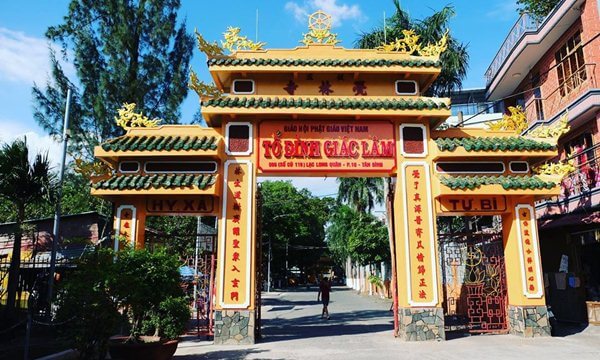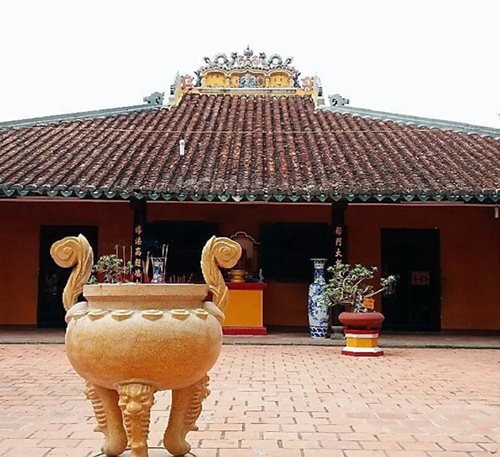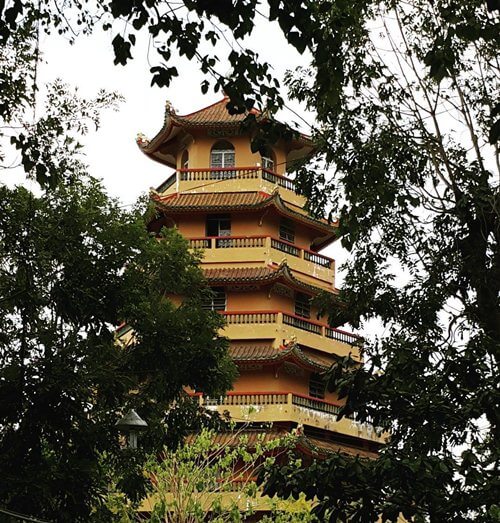Giac Lam Pagoda is one of the oldest temples in Ho Chi Minh City, Vietnam, bringing a spiritual atmosphere and unique architecture.

Giac Lam Pagoda in Ho Chi Minh City
- Address: 565 Lac Long Quan Street, Ward 10, Tan Binh District, Ho Chi Minh City, Vietnam
- Opening hours: 7:00 am – 12:00 pm, and 2:00 pm – 5:00 pm for visiting
- Entrance fee: Free
- Phone: 028 3865 3933
Giac Lam Pagoda is the ancient architecture of temples in South Vietnam. This pagoda is the site of the Thien Lam Te Tong sect. In 1988, the Ministry of Culture and Information recognized the temple as the National historical-cultural relic of Vietnam.
1. History of Giac Lam Pagoda
The pagoda was built in 1744 by layman Ly Thuy Long. Initially, the pagoda was named Son Can (Son is Mountain, Can means Mound). Then, people called it Cam Son because it locates on Cam Son hillock.
Beside, Giac Lam pagoda had another name called Cam Dem because the layman Thuy Long had his own name Cam, specialized in knitting mattress (Dem), and the local called him Cam Dem.
In about 1774, Zen master Vien Quang took over the temple. At this time, he changed the name of the pagoda to Giac Lam Pagoda.
Under the Zen master Vien Quang, Giac Lam Pagoda became the first training centre on sutras and disciplines for monks in Gia Dinh and the South.
In 1873, under the abbot of Zen Master Minh Khiem, the pagoda was also the place to print, copy scriptures, engrave wooden scriptures, and write into Nom script from some Buddhist books.
Since its establishment up to now, Giac Lam Pagoda has eight leaders. The current host of the institute of the pagoda is Venerable Thich Hue Trung, the abbot is Venerable Thich Tu Tanh, and the deputy abbot is Venerable Thich Tu Tri.
2. The architecture of Giac Lam Pagoda
The architecture of Giac Lam Pagoda is considered to represent the Southern temple style.

Since its construction up to now, Giac Lam Pagoda has been restored many times, but the major restoration was in 1798 – 1804 under the abbot of Zen master Vien Quang. The second major restoration was organized by Zen masters Nhu Loi, Nhu Phong, Hong Hung in 1908 – 1909. Currently, the architecture of the temple still bears the style of the last reconstruction.
Later, the pagoda was built and repaired more. Typically, in 1939 – 1945, the pagoda built a fence. In 1955, the temple added a three-door gate. After 1975, the pagoda was re-roofed with tiles and lined with bricks in the front yard of the main hall.
Giac Lam pagoda currently has a “Tam-word” architecture consisting of three adjacent rows of houses, excluding the outbuildings:
- Main temple,
- Teaching room,
- Trai room (also known as the house of Mr Giam).
The main temple is quite wide and deep. There are 56 large columns, on each column engraved with the opposite-word sentences, meticulous gold carving. This area worships a lot of statues of Buddha.
3. The highlights of Giac Lam Pagoda
The area in front of the yard is a garden, having a small temple with a stone statue of Bodhisattva (Quan The Am). In the garden, there is a large buddha tree given by Mr Narada. And it was planted by him and monk Hong Tu and Su Buu on June 24, 1953.
In front of Giac Lam pagoda is the relic stupa of Xa Loi Buddha. In 1970, the construction of the stupa was started, but it was suspended. Until 1993, the building was continued and completed in 1994. The 7-storey tower has a hexagonal shape, with a height of nearly 33m and an area of more than 600m2, facing the north. And, many statues of Buddha are worshipped inside the tower. This tower is one place of the pagoda where the visitors often take pictures.

The next highlight of Giac Lam Pagoda is the system of 119 Buddha statues, which are 113 ancient statues made of different materials: wood, copper, cement, and gypsum. The most famous ones are the wooden statue of Thich Ca, the oldest statue in the temple; the bronze statue of the newborn Thich Ca; two sets of Arhat; and a set of statues of the Ngu Hien (Buddha and four Bodhisattvas).
In addition, the pagoda also preserves many wood carvings with rich historical, cultural, and artistic values, such as 23 diaphragms; 86 gold sentences, and 46 ancient weapons and worship tools.
Another typical feature is that the pagoda uses 7,454 plates to decorate along the walls of the Tay Duong (West Temple), the Buddha temple, the ancestor tower, the roofs, etc. Most of the porcelain plates came from Lai Thieu, Binh Duong Province (a site near HCMC).
On November 30, 2007, the centre of the Vietnam Record book set a record of Giac Lam Pagoda that has the most number of decorative plates in Vietnam.
4. Festivals at Giac Lam Pagoda
Like other temples, Giac Lam Pagoda is a famous site with tranquil space. Therefore, on special occasions, such as the full moon of the first lunar month, the Vu Lan festival (the full moon of 7th lunar month), the pagoda organizes big festival activities. The pagoda attracts monks, Buddhists as well as tourists visiting the temples and pray for good luck and peace.
>>> You may want to see a holy pagoda in Saigon: Jade Emperor Pagoda.